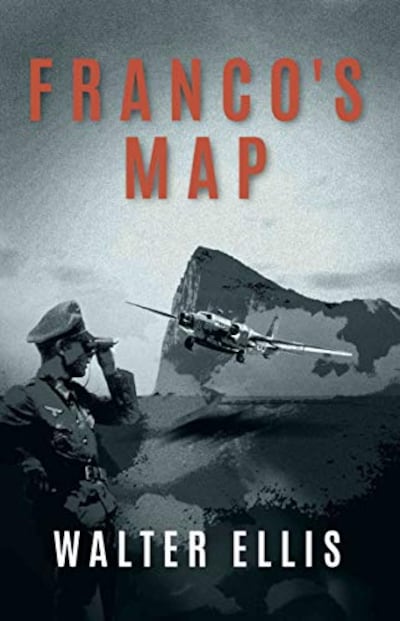The second World War is the gift to fiction that keeps on giving. I have no idea how many novels have depended for their success, indeed their very existence, on the life and career of Adolf Hitler, but it must run into the thousands.
Not many, however, have a strong Irish dimension. Franco’s Map does, from the funeral of O’Donovan Rossa in Glasnevin in 1915, to the burning of the big houses of the Ascendancy, to the role played by a maverick, half-Spanish Dubliner – a veteran of the IRA and the International Brigades – in saving Gibraltar from the Nazis.

I admit it, I am a sucker for a good WWII thriller. With the exception of the detective novel, no other subject has proved as fruitful for so many writers for so long. The rise and fall of the Third Reich is the greatest story ever sold, yet it is never told in quite the same way twice. There is always some new territory to explore.
Which brings me (with apologies) to my own contribution to the genre, set in Madrid in 1940, six months after the end of the Spanish Civil War.
The origins of my story lie in the margins of Alan Furst’s superb 1996 novel The World at Night, in which a louche Parisian filmmaker, Jean Casson, finds himself transformed against his will into a hero of the Resistance.
At one point in the story, Casson is on a train from occupied Paris to Madrid when a companion happens to mention that the British will be up against it if Hitler and Franco should decide to join forces and launch an assault on Gibraltar.
I was dumbstruck. This had never occurred to me. Gibraltar was for 200 years the buckle on the British imperial belt. It guarded the entrance to the Mediterranean and provided a base for the royal navy’s Force H. If it had been lost to the Wehrmacht, the Battle of Tarranto would not have happened, the French fleet in Mers-El-Kebir would likely have gone over to the Germans, Malta would have fallen and, worst of all, Britain’s Eighth Army would have been stranded in Egypt. In short, Churchill would almost certainly have been forced to sue for peace.
It didn’t happen. The Rock remained under British control, playing a vital role in securing the defeat of Rommel and, in 1942, providing the secure base from which General Eisenhower launched Operation Torch.
Getting the background to the story right, including the tense political atmosphere, the regime’s strong pro-Nazi sentiment and the sorry state of the Spanish economy and people, wasn’t easy. I had never attempted such a thing before. My two previously published books were both nonfiction – a critique of elite education in Britain and The Beginning of the End, a memoir of growing up in Belfast by the side of my friend Ronnie Bunting, who went on to be a leader of the INLA.

My only previous excursion into fiction was The [sadly named] Caravaggio Conspiracy, a baroque mystery that, as the slightly better-sounding Il Codici Caravaggio, was briefly number one in Italy and also (to my surprise) a minor hit in Bulgaria.
A great deal of reading and research went into the writing, starting with details of Operation Felix, the name the Germans gave to their very detailed plan to expel the British from Gibraltar, replacing Force H with a U-boat pen and a surface squadron led by the super battleship Tirpitz. Franco was enthusastic at first. Restoring the Rock to la Madre Patria had, after all, been a central aim of state policy since 1704. But in the end, he rebuffed the Führer, who responded, in a fit of pique, by bringing forward his disastrous plan to invade the Soviet Union.
In 1945, Reichsmarschall Hermann Göring told his American interrogators in Nuremberg that Germany’s failure to take Gibraltar was one of the greatest mistakes of the war.
My version of why Franco said no (allowing for a deal of fictional fancy) is based on real events, but is also, as all thrillers must be, both a tale of derring-do and a love story.
We start with a young British army officer, Charles Bramall, whose Ascendancy family was driven at gunpoint from Co Monaghan amid the chaotic early days of the Free State. A fluent Spanish speaker who reported from the nationalist side in the Civil War, he has been sent by MI6 to find some way of driving a wedge between Hitler and Franco – though with little expectation that he will succeed.
Eddy Romero could hardly be more different. His socialist father settled in Dublin after fleeing a previous Spanish dictatorship and he burns with a hatred of the British empire. Eddy’s links to Bramall go back further than either of them know or would ever wish. Finally, there is Isabel Ortega, the beautiful (well, what did you expect?) high-born daughter of a top government official. She is a Spanish patriot but rejects the fascism espoused by her ambitious father.
And if that is not enough for you, there is a sub-plot detailing what happens to the pro-Hitler duke and duchess of Windsor when they turn up, unannounced, in Madrid after the fall of France.
World War II. You couldn't beat it with a big stick.
Franco's Map is available on Amazon, from Waterstones and, in Ireland, from Kenny's online bookshop, at kennys.ie










